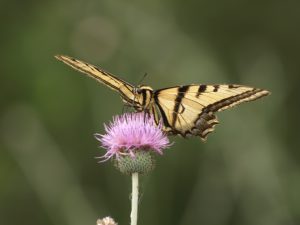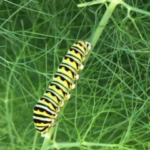Create Healthy Habitats With Butterfly Gardening

Eastern Tiger Swallowtail (Papilio glaucus Linnaeus)
Butterfly gardening is growing in popularity; and for good reason. Butterflies add interest and beauty to the landscape. Texas has over a hundred butterfly species and many of them visit the Austin area. Kids absolutely love them and the wonder of watching a caterpillar transform into a butterfly is captivating enough to keep both children and adults mesmerized.
Purposely attracting butterflies to your garden also teaches us how to create healthy insect habitats. When it comes to butterflies the old adage is true, “if you build it they will come!”
Nectar and Larval Food Both Important

Black Swallowtail Caterpillar (Papilio polyxenes)
Adult butterflies are attracted to many flowering plants as nectar sources. Try to create a landscape that has a succession of flowering plants to provide nectar all season. You can see our list of annual flowers by blooming season here and don’t forget about wildflowers. Adult butterflies are also attracted to fermenting sap on tree trunks and wet soil areas for water and minerals.
Other plants serve as food for the butterfly larva (caterpillars.) Our most common butterfly gardening species, include the black swallowtail on parsley, dill or fennel, the gulf frittilary on passion vine, and monarch butterfly on milkweeds. Senna or cassia species are hosts to the orange-barred sulphur and similar species.
Use Integrated Pest Management Practices
A healthy butterfly habitat means that some plants are going to receive hordes of hungry caterpillars. Practice Integrated Pest Management (IPM) before reacting – it may be a beautiful butterfly that you are killing. The principles of IPM are:
- Accurately diagnose problems before considering any treatment
- Establish an action threshold – decide how much damage can be tolerated
- Use biological controls or management practices to reduce or prevent the damage
- Use least-toxic solutions when addressing landscape problems
Additional Butterfly Gardening Resources
Butterfly Plants for Austin
Creating and Insect and Pollinator Friendly Garden
Butterfly Gardening in Texas
Butterfly Gardening Basics (U. of Florida)
Incorporating Butterfly Plants in Your Garden (FloridaGardener.com)
Butterflies and Moths of North America
Order Lepidoptera Insect Field Guide
Monarch Joint Venture
Journey North
Monarch Watch
Ornamental Plants for Austin
